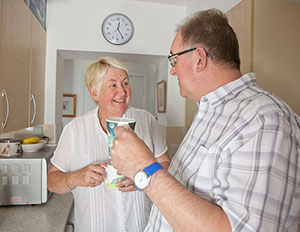Low Carbon Building expert and Professor of Architecture and Climate Change, Rajat Gupta along with a research associate, Matt Gregg, will spend two years monitoring the Victorian end terrace in Oxford’s Nelson Street – the most energy efficient and low carbon home in the city.
Data about the terraced house’s temperature, humidity and carbon dioxide (CO2) content will be captured by the Oxford Brookes researchers in real-time thanks to small sensors fitted throughout the building as part of the whole-house monitoring system.
Consumption of gas, electricity and water will also be recorded and Rajat will even know when windows and doors are opened.
Eco house: Steve and Shirley Bishop Remote monitoring means that the householders Steve Bishop and his wife Shirley will live in will be a home and not a science experiment.
“We don’t want these people to be guinea pigs,” explains Rajat. “It’s not a lab house.” However, he can feed back to the couple if energy use shows an unforeseen spike.
“I can see electricity use from minute to minute. In the night electricity use should go down so if I’m finding it isn’t I can tell Steve and Shirley and it may be because a TV has been left on.”
One of the big changes to the property has been in the air quality of the house: “This was a house that was harmful to occupants,” explains Rajat. Concentrations of carbon dioxide were more than triple what they should be.
“This was harmful because they never opened the windows as they were afraid they would lose the heat.
“This home has 24-hour occupancy and that’s the story of many houses in the UK. So air quality is even more important because occupants may be older people with health problems.”

